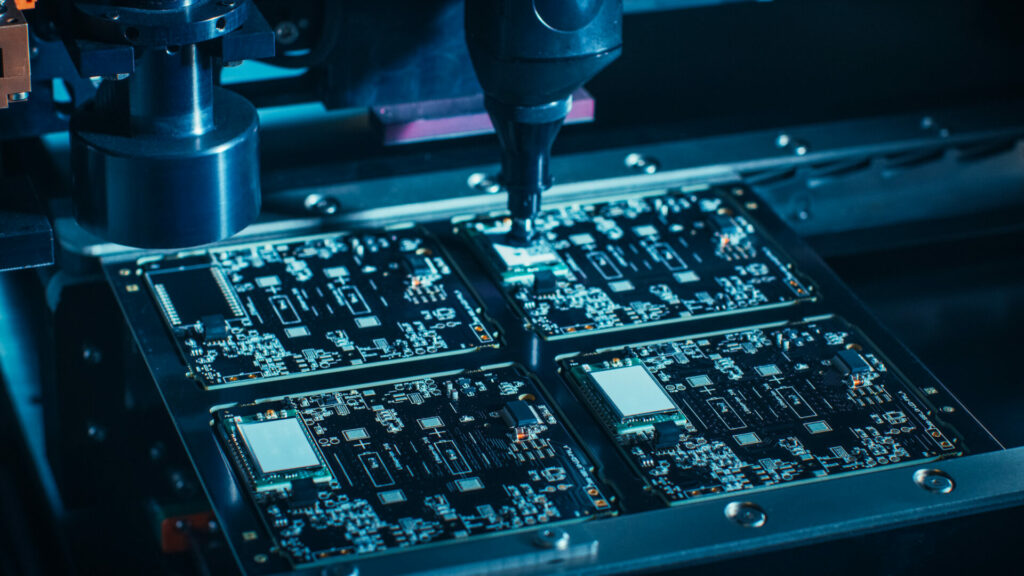
When the components for your printed circuit boards (PCBs) have been sourced and gathered, they need to be physically mounted to the board itself. This is known as the assembly process.
Generally speaking, there are two main approaches to this process: surface mount technology (also known as SMT assembly), or through-hole technology (also known as THT assembly).
Both of these assembly methods have their own positives and drawbacks. As a result, the right assembly service for your needs will depend on the scope of the project and the needs of the PCB.
In this blog, we’ll outline the SMT process in detail. In doing so, we’ll help you understand what it is, when it’s needed and what the process looks like. We’ll also discuss how it’s different from the THT assembly process.
What is SMT and when do you need it?
Surface mount technology (SMT) involves soldering PCB components into their required locations on the PCB’s substrate. With this method, surface mount components (SMCs) are soldered onto the board directly through reflow soldering.
Due to this, the SMT process is much quicker than the THT assembly process, which requires passing the conductive ‘legs’ of your components through small apertures and then soldering them to pads on the reverse face.
Plus, the SMT process can be made even more efficient through the use of a pick and place PCB assembly machine. This machine can be used to arrange all of the components accurately and at speed before the soldering process begins.
On top of this, it’s also worth keeping in mind that components that are designed for SMT layouts often tend to be smaller and cheaper than those that are designed for THT builds. Due to this, our SMT assembly service is usually the preferred option when people want to keep costs low and save space.
What does the process look like?
The SMT process starts during the design phase, when the components are selected and the PCB itself is designed. By starting the process at such an early stage, all aspects of assembly can be considered. Starting the SMT process at this point also makes production more straightforward.
Once the PCB has been designed and you’ve decided the SMT process is the right one for your needs, the assembly can begin. This involves the following three stages (and multiple inspection points):
What is THT and how is it different?
The SMT process involves soldering components into their required locations directly on the board’s substrate. However, through-hole technology (THT) involves passing the conductive ‘legs’ – fine wire leads – of your components through small apertures that have been machined into the substrate at specific points. Following this, the ‘legs’ are then soldered onto pads on the reverse face.
Although SMT assembly has its merits, THT assembly is an ideal option when a sturdier physical bond is important at component solder points. Certain types of connectors or hardware devices can benefit greatly from this, depending on their intended application.
THT assembly takes longer than SMT assembly because additional steps are involved in both the design and manufacturing stages of the project. That said, the soldering on a THT-assembled board can be done entirely manually or it can be automated to an extent using a dedicated insertion mount machine.
You should also be aware that components that are designed for THT mounting are often larger and command slightly higher prices than their SMT equivalents. This is in part because they need to be produced with the necessary conductive ‘legs’ so that they can be inserted and secured through the PCB substrate.
Whichever of the two PCB assembly methods you use, quality soldering is essential. For your PCB to perform optimally and efficiently in its designated role, you’ll need a blend of craftsmanship, experience, tools and attention to detail. For this reason, you should always consult an expert like us.
How can ABL help?
Here at ABL Circuits, we’re one of the UK’s leading PCB assembly companies. As a result, we’re proud to offer a full range of PCB assembly options, including an SMT assembly service.
Our skilled, qualified and highly-trained team can take care of all aspects of the PCB assembly process, from component procurement and mounting, to physical soldering and testing. Our staff have decades of hands-on experience in this area and are experts at working with precise briefs and specifications.
We have more than 30 years of experience in the industry and we pride ourselves on getting the job done right the first time, every time. On top of this, our turnaround times and your satisfaction are guaranteed.
Book a free quote today!
Ready to get started? Request a free quote from the team today. Alternatively, if you’d like to speak to a member of the team about our SMT assembly service, please don’t hesitate to get in touch with us. We’d love to help you.
